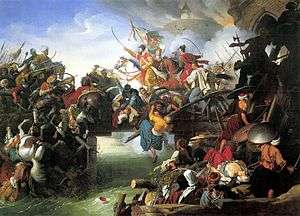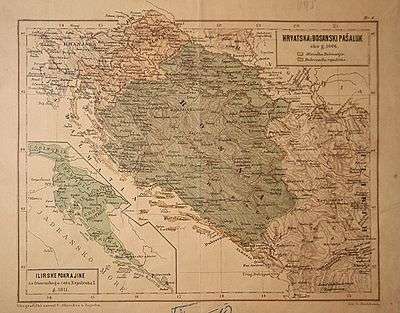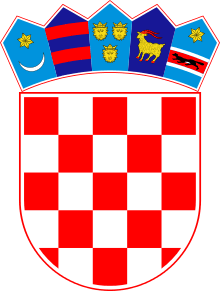Hundred Years' Croatian–Ottoman War
The Hundred Years' Croatian–Ottoman War (Croatian: Stogodišnji hrvatsko-turski rat,[1][2] Stogodišnji rat protiv Turaka,[3][4] Stogodišnji rat s Osmanlijama[5]) is the name for a sequence of conflicts, mostly of relatively low intensity, ("Small War", Croatian: Mali rat[2]) between the Ottoman Empire and the medieval Kingdom of Croatia (ruled by the Jagiellon and Zápolya dynasties), and the later Habsburg Kingdom of Croatia.
| Hundred Years' Croatian–Ottoman War | |||||||
|---|---|---|---|---|---|---|---|
| Part of the Croatian–Ottoman Wars, Ottoman–Hungarian Wars, Ottoman–Habsburg wars and the Ottoman Wars in Europe | |||||||
 Nikola Šubić Zrinski's charge from the fortress of Szigetvár during the Siege of Szigetvár | |||||||
| |||||||
| Belligerents | |||||||
|
Until 1526: |
Until 1526: | ||||||
|
From 1527: |
From 1527:
| ||||||
| Commanders and leaders | |||||||
|
Croatian Ban, various Croatian feudal lords |
Ottoman Sultan, Bosnian Beglerbeg | ||||||
Pope Leo X called Croatia the Antemurale Christianitatis ("Bulwark of Christianity") in 1519,[6] given that Croatian soldiers made significant contributions to the struggle against the Turks. The advancement of the Ottoman Empire in Europe was stopped in 1593 on Croatian soil (Battle of Sisak). Nevertheless, the Muslim Ottoman Empire occupied parts of Croatia from the 16th to the end of the 17th century.
Time span
There are several different variations about the exact length of the war. According to one group of historians, the war began with the Battle of Krbava Field in 1493, and ended with the Battle of Sisak in 1593.[7]
According to the other group of historians, the war lasted from the second half of the 15th century and into the entire 16th century.[8]
A third group of historians mark the Peace of Zsitvatorok in 1606 as the end of the war. The war was won by the Ottoman's defeat upon their advance on the Kupa river border, with the remainder of Croatia's territory consisting of only 16,800 km².[9]
In light of the human and territorial loss, and also from the modern Croatian Romanticist point of view, the 15th and 16th centuries were known as the "Two centuries of Croatia in mourning" (Latin: Plorantis Croatiae saecula duo carmine descripta) in the lyric-epic poem of Pavao Ritter Vitezović from 1703.[10]
Battlefield
The battlefields were concentrated in the central-eastern areas of the Kingdom of Croatia, stretching from the eastern border of the pre-Ottoman times to the eastern border of the "reliquiae reliquiarum olim inclyti regni Croatiae" ("remnants of the remnants of the once great kingdom of Croatia").
After the 1493 Croatian defeat at Krbava, the Ottomans started the occupation of significant forts: Knin and Skradin fell in 1522.[11] The Battle of Mohács happened in 1526. Jajce fell in 1528, Požega in 1536, Klis fell in 1537, Nadin and Vrana in 1538, moving the Croatian-Ottoman border to the line, roughly, Požega-Bihać-Velebit-Zrmanja-Cetina.[11]
By the end of 1540, the Ottoman Empire occupied the Croatian possessions between Skradin and Karin, eliminating them as a buffer zone between the Ottoman and Venetian territory in Dalmatia.[12] By 1573, the remainder of the Dalmatian hinterland, now largely controlled by the Venetian cities, was even further reduced by Ottoman advances.[13]

International impact
Although the Croatian Kingdom suffered major defeats in battles, it remained in existence, keeping its identity, religion, and culture under the Habsburg Monarchy. In addition, some Croats in the territories lost to the Ottomans remained because the Porte embraced ethnic diversity, many of them eventually converting to Islam throughout the following centuries of Ottoman rule.
The Croatian combat against the Ottomans did not remain unnoticed in the political circles of European states. Copious amounts of information from the war was written in Monumenta Hungariae Historica, Codex diplomaticus partium Regno Hungariae adnexarum from 1903 (over 600 documents).
Type of conflicts
During those 100 years (or 150 years, depending on criteria), the war on the territory of Kingdom of Croatia was overall a series of smaller armed conflicts ("small war") over the long duration of the war (in other words, armies were not always in constant battle.)
The Ottoman tactic consisted of persistent loot and scorching raids whose aim was to intimidate and demoralize the local civil inhabitants, to exhaust the economic opportunities and disable the normal economic life on the frontier areas. On the other side, Croatian and allied Christian forces implemented counterattacks, especially in the first phases of war, when they were still able to apply the counterattacking or the offensive tactics. Despite these destructive tactics, the armies did sometimes clash. Sometimes the local armies intercepted or pursued the raiders in their return from the raid. There was also more intense military actions, such as the Battle of Krbava Field or the Battle of Sisak.
Zones of war peril
The war-endangered areas can be classified in three zones:
- The first zone was the territory of Kingdom of Croatia, that had no effective control by both sides, as well as the parts of Kingdom of Croatia that were heavily struck by the Ottoman military and paramilitary operations. This zone was up to 50 km deep in the Croatian territory. It mostly covered the areas along the border and the later-formed Military Frontier. The infrastructure and the supra-structure became ruined and devastated, and the economic life suffered. This zone had high rate of emigration, mostly to the second and the third zones, along with emigrations abroad.
- The second zone was from time to time exposed to the raids of the Ottoman regular and irregular forces. The area was controlled by the Croatian authorities and the economic life was still somewhat functioning. Population level was steady and received a continuous inflow of displacees from the first zone. The Croatian nobles used this zone as the support point and the base for the defense or for the attempts of retaking of their estates in the first zone. These areas lived as economic support of the armies.
- The third zone was mostly Ottoman raid-safe zone, in which the majority of the zone had no Ottoman raids, although few areas were subjected to Ottoman raids.[14]
References
- (in Croatian) Hrvatska znanstvena bibliografija Mirko Valentić: Stogodišnji hrvatsko-turski rat (1493-1593) - Od kraja 15. st. do kraja Prvoga svjetskog rata, Školska knjiga, Zagreb, 2005, ISBN 953-0-60577-3
- (in Croatian) Kraljevina Hrvatska i Kraljevina Ugarska Kratka politicka i kulturna povijest Hrvatske
- (in Croatian) Filozofski fakultet u Mostaru Archived 2012-03-05 at the Wayback Machine Kolegij Hrvatska povijest srednjega vijeka]
- (in Croatian) Deseta gimnazija Ivan Supek, Zagreb Archived 2016-03-04 at the Wayback Machine Zbirka zadataka za 2. razred
- (in Croatian) ARHiNET arhivski informacijski sistem
- Velikonja, Mitja (2003). Religious Separation and Political Intolerance in Bosnia-Herzegovina. Texas A&M University Press. p. 78. ISBN 978-1-60344-724-9.
- (in Croatian) Hrvatski studiji Archived 2010-10-11 at the Wayback Machine Studij povijesti
- (in Croatian) Hercegbosna.org Mladen Ančić: Hrvatski ulog u Bosni, 2. prosinca 2009.
- (in Croatian) Milan Kruhek: Granice Hrvatskog Kraljevstva u međunarodnim državnim ugovorima, Povijesni prilozi 10/1991., str.37-39, ISSN 0351-9767
- (in Croatian) ARHiNET arhivski informacijski sistem Pavao Ritter Vitezović
- Raukar, Tomislav (October 1990). "Hrvatska na razmeđu XV i XVI. stoljeća". Senjer Jahrbuch (in Croatian). 10 (1): 5–14. ISSN 0582-673X. Retrieved 2012-07-08.
- Bogumil Hrabak (September 1986). "Turske provale i osvajanja na području današnje severne Dalmacije do sredine XVI. stoleća". Journal of the Institute of Croatian History (in Serbian). 19 (1). ISSN 0353-295X. Retrieved 2012-07-08.
- Raukar, Tomislav (November 1977). "Venecija i ekonomski razvoj Dalmacije u XV i XVI stoljeću". Journal of the Institute of Croatian History (in Croatian). 10 (1): 221. ISSN 0353-295X. Retrieved 2012-07-08.
- Ivan Jurković (September 2003). "Klasifikacija hrvatskih raseljenika za trajanja osmanske ugroze (od 1463. do 1593.)" [Classification of Displacees Among Croats During the Ottoman Peril (from 1463 till 1593)]. Migracijske i Etničke Teme (in Croatian). 19 (2–3): 147–174. ISSN 1333-2546. Retrieved 5 November 2011.
Bibliography
- Milan Kruhek: Granice Hrvatskog Kraljevstva u međunarodnim državnim ugovorima, Povijesni prilozi 10/1991, p. 37-79, ISSN 0351-9767
- Ferdo Šišić: Pregled povijesti hrvatskog naroda 600.-1526.


